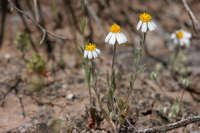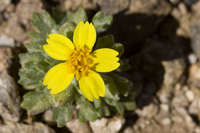Annuals, perennials, subshrubs, or shrubs, 1-200 cm. Stems erect or decumbent, usually branched (proximally, distally, or ± throughout). Leaves mostly cauline; mostly alternate (proximal sometimes opposite); petiolate or sessile; blades usually 1-2(-3)-pinnately lobed, ultimate margins toothed, serrate, or entire, faces usually densely to sparsely woolly (abaxial or both, adaxial sometimes glabrescent). Heads radiate or discoid, borne singly or in loose to tight, corymbiform or compound-corymbiform arrays. Involucres campanulate to hemispheric, 3-12+ mm diam. Phyllaries persistent, 4-13(-15) in 1+ series (± erect in fruit, distinct or basally connate, lanceolate to oblanceolate, herbaceous or indurate, slightly to deeply concave, usually carinate, margins sometimes scarious, abaxial faces densely to sparsely woolly). Receptacles flat or convex to conic, smooth or pitted, glabrous, usually epaleate (with 1-6 hyaline paleae in E. ambiguum, obscurely setose in E. mohavense). Ray florets 0, or 4-13(-15), pistillate, fertile; corollas yellow or white (sometimes with reddish veins in E. lanosum). Disc florets (3-)10-300, bisexual, fertile; corollas yellow, tubes shorter than or about equaling funnelform throats, lobes 5, deltate. Cypselae linear-clavate to prismatic, flattened or 3-angled in rays, 4(-5)-angled in discs, hairy or glabrous; pappi 0, or persistent, of 6-12+ (distinct) erose to laciniate or aristate scales (in 1-2 similar or contrasting series), or ± coroniform. x = 8.
Eriophyllum encompasses taxa that occur in seashore, chaparral, grassland, desert, forest, and alpine communities. Their disparateness encouraged taxonomic multiplication. Between 1890 and 1937, about 157 designations under the genus existed (L. Constance 1937). Constance reduced that taxonomic thicket to six annual and five perennial species; the perennial species E. lanatum consisted of ten varieties. Base diploid chromosome numbers for Eriophyllum (in the sense of Constance) species are x = 4, 5, and 7 for the annuals, and x = 8, 15, and 19 for the perennials (S. Carlquist 1956; J. S. Mooring 1997, 2001, 2002). Possibly, x = 15 and x = 19 represent paleopolyploidy. Only E. mohavense remains uncounted. B. G. Baldwin (1999) linked Mooring´s (1997) report of n = 19 in E. nevinii to chromosomal, morphologic, and rDNA evidence, and erected the genus Constancea on that species. Eriophyllum (in the sense of Constance) seems most closely related to the annuals Pseudobahia (x = 3, 4, 8) and Syntrichopappus (x = 6, 7). Eriophyllum (in the sense of Baldwin), Pseudobahia, and Syntrichopappus constitute a clade, and nomenclatural changes are necessary for a monophyletic classification (Baldwin and B. L. Wessa 2000; Baldwin et al. 2002). Mooring (1997) hypothesized a descending dysploidy phylogeny in Eriophyllum (in the sense of Constance) from E. nevinii. Baldwin et al. (2002, p. 174) stated that E. nevinii 'is an evolutionary outlier (although probably not ancestral) to' Eriophyllum in the sense of Constance. Natural intertaxon hybrids have been reported for the perennial species (L. Constance 1937; J. S. Mooring 1994) but not for the annuals. Experimental hybridizations have produced sterile hybrids between the annual E. congdonii and the perennial E. lanatum. Experimental crosses among seven of the annual species produced fertile hybrids between two morphologically similar species; the other combinations either failed or produced sterile hybrids (Mooring 2002). D. P. Tibor (2001) cited nine taxa of Eriophyllum as rare or endangered: the perennials E. confertiflorum var. tanacetiflorum, E. jepsonii, E. latilobum, E. (Constancea) nevinii, and E. lanatum vars. hallii and obovatum, and the annuals E. congdonii, E. mohavense











